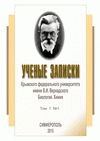Organic farming was conceived as a strategy to promote favorable environmental conditions, preserve and restore soil fertility, and as a pathway toward sustainable agriculture. By stabilizing agroecosystems, organic farming enables the production of non-record-breaking yet relatively stable yields. Agroecosystem sustainability is achieved through appropriate crop rotations and balanced microbial and enzymatic pools in soils not subjected to synthetic fertilizers or pesticides. The exact timeframe for stabilizing soil biological and biochemical properties during the transition to organic farming remains unclear, making the study of temporal changes in microbial and enzymatic pools an ongoing research priority. The aim of this study was to compare microbiological and biochemical soil properties under varying durations of organic farming implementation. The study focused on soils from three farms in the Republic of Tatarstan practicing organic farming for 5, 10, and 25 years, respectively. We compared these soils with those from neighboring farms using traditional practices and undisturbed background sites. Soil samples were collected in spring and autumn 2024. Microbial abundance across five trophic groups was determined via cultivation on solid media, alongside the activity of three enzymes (invertase, phosphatase, and catalase). Eco-trophic indices, including humification and organic residue transformation coefficients, were calculated. Phosphatase activity emerged as the most robust biomarker for assessing the duration of organic farming adoption. The ratio of phosphatase activity in organic versus traditional fields exhibited consistent and statistically significant trends: after 5 years, activity was significantly lower in organic fields; after 10 years, no differences were observed; and after 25 years, activity became significantly higher in organic fields. The introduction of nitrogen fertilizers helps improve nitrogen nutrition and stimulate phosphatase activity. For this reason, a decrease in phosphatase activity is observed in the first years after the transition to organic farming. However, in the absence of regular doping in the form of mineral fertilizers, self-regulation mechanisms in the ecosystem come into force. With a lack of mobile phosphorus in the soil, the flow of phosphatases of microbial and plant origin into the soil increases. In gray forest soils, Azotobacter bacteria served as a reliable indicator to distinguish cultivated from uncultivated areas, regardless of farming practices. In chernozems, however, Azotobacter abundance reflected soil moisture levels rather than land use type. Seasonal variations significantly affected all five microbial trophic groups, with higher abundances in spring than autumn. Differences between organic and traditional fields were limited to trends in specific groups, such as higher mean abundances of ammonifiers and amylolytics in organic soils. Actinomycetes belong to the group of amylolytic microorganisms, although they are counted separately. For microscopic fungi, seasonal fluctuations in abundance are less pronounced than for other trophic groups, and for autochthonous microflora, seasonal fluctuations in abundance are expressed best of all. These patterns were consistent across farms with differing organic farming histories. Among eco-trophic indices, the humification coefficient and organic residue transformation coefficient showed promise but require further validation. The humification coefficient was significantly higher in fields with 25 years of organic farming compared to adjacent traditional fields.
soil, organic farming, enzyme activity, trophic groups of microorganisms, eco-trophic indices
1. Bachin S. Organika mify i real'nost' / S. Bachin. – M.:OOO «HlebSol'», 2016. – 128 s.
2. Semenov A. M. Zdorovaya pochvennaya ekosistema – osnova zdorovogo fitocenoza / A.M. Semenov, A. P. Glinushkin, M. S. Sokolov // Uspehi sovremennoy nauki. – 2017. – T. 2, № 10. – S. 29–33.
3. Veklenko V. I. Osnovnye napravleniya vosproizvodstva zemel'nyh resursov / V. I. Veklenko, V. V. Duplin, N. D Zhmakina // Vestnik Kurskoy gosudarstvennoy sel'skohozyaystvennoy akademii.
4. Kislov A. V. Regulirovanie vosproizvodstva organicheskogo veschestva i gumusa v pochve pri organizacii sevooborotov v biologicheskom zemledelii na Yuzhnom Urale / A. V. Kislov,
5. Dolgopolova N. V. Plodorodie pochvy i ustoychivost' sistemy zemledeliya – zalog proizvodstva sel'skohozyaystvennoy produkcii / N. V. Dolgopolova, A. A. Man'shin, M. Zh. Ashirbekov,
6. Sokolov M. S. Zdorovaya pochva – uslovie razvitiya agro- i sociosfer (problemno-analiticheskiy obzor) / M. S. Sokolov, A. M. Semenov, Yu. Ya. Spiridonov, E. Yu. Toropova, A. P. Glinushkin
7. Zarb J. The importance of microorganisms in organic agriculture / J. Zarb, R. Ghorbani, A. Koochekiand, C. Leifert // Outlooks on Pest Management. – 2005. – No 16(2). – P. 52–55.
8. Emcev V. T. Mikrobiologiya / V. T. Emcev, E. N. Mishustin. – M.: Drofa, 2008. – 445 s.
9. Kulikova A. H. Fermentativnaya aktivnost' pochvy v zavisimosti ot sistem udobreniya / A. H. Kulikova, S. A. Antonova, A. V. Kozlov // Vestnik Ul'yanovskoy gosudarstvennoy
10. Kalashnikov R. P. Vliyanie mineral'nyh udobreniy na fermentativnuyu aktivnost' chernozemovidnoy pochvy pod posevami kukuruzy / R. P. Kalashnikov, E. A. Semenova, S. A. Fokin, E. B. Zaharova
11. Labutova N. M. Osnovy pochvennoy enzimologii / N. M. Labutova, T. A. Bankina. – Sankt-Peterburg: Izdatel'skiy dom Sankt-Peterburgskogo gos. un-ta, 2013. – 102 s.
12. Postovalov A. A. Rol' mineral'nyh udobreniy v povyshenii supressivnosti pochvy i ogranichenii razvitiya kornevoy gnili / A. A. Postovalov, S. F. Suhanova // Izvestiya Gorskogo
13. Zinchenko M. K. Vliyanie priemov obrabotki i doz udobreniy na fermentativnuyu aktivnost' seroy lesnoy pochvy / M. K. Zinchenko, S. I. Zinchenko // Vestnik Kurskoy gosudarstvennoy
14. Gordeeva K. A. Vliyanie razlichnyh sistem zemledeliya na agrohimicheskie i biohimicheskie pokazateli seroy lesnoy pochvy / K. A. Gordeeva, T. G. Kol'cova, V. I. Kulagina
15. Kol'cova T. G. Ocenka fermentativnoy aktivnosti seryh lesnyh pochv v organicheskih i tradicionnyh argocenozah Predkam'ya Respubliki Tatarstan / T. G. Kol'cova, V. I. Kulagina,
16. Dadenko E. V. Primenenie pokazateley fermentativnoy aktivnosti pri ocenke sostoyaniya pochv pod sel'skohozyaystvennymi ugod'yami / E. V. Dadenko, M. A. Prudnikova, K. Sh. Kazeev
17. Gaziev M. A. Rol' organicheskih i mineral'nyh udobreniy v razvitii fiziologicheskih grupp mikroorganizmov v sisteme sevooborota / M. A. Gaziev, A. T. Turdaliev, M. Sh. Nizometdinov
18. Kulagina V. I. Informativnost' mikrobiologicheskih i biohimicheskih parametrov dlya monitoringa pochv pri organicheskom zemledelii / V. I. Kulagina, L. M. Sungatullina, S. S. Ryazanov
19. Kazeev K. Sh. Biodiagnostika pochv: metodologiya i metody issledovaniy: / K. Sh. Kazeev, S. I. Kolesnikov. – Rostov-na-Donu: Izdatel'stvo Yuzhnogo federal'nogo universiteta, 2012. – 260 s.
20. Kulagina V. I. Proverka nabora parametrov dlya integral'noy ocenki ekologo-biologicheskogo sostoyaniya pochv pri organicheskom zemledelii / V. I. Kulagina, L. M. Sungatullina, S. S. Ryazanov,
21. Zinchenko M. K. Monitoring chislennosti bakterial'noy mikroflory v agroekosistemah seroy lesnoy pochvy / M. K. Zinchenko // Dostizheniya nauki i tehniki APK. – 2019. – T. 33, № 12. – S. 10–14.
22. Zav'yalova N. E. Mikrobiologicheskoe sostoyanie dernovo-podzolistoy pochvy Predural'ya pri dlitel'nom primenenii organicheskih i mineral'nyh udobreniy / N. E. Zav'yalova, I. G.
23. Blagoveschenskaya G. G. Mikrobnye soobschestva pochv i ih funkcionirovanie v usloviyah primeneniya sredstv himizacii / G. G. Blagoveschenskaya, T. M. Duhanina // Agrohimiya. – 2004. – №2. – S.80–88.
24. Devyatova T. A. Vliyanie sel'skohozyaystvennyh ugodiy i podtipa pochvy na mikrobnoe soobschestvo zonal'nyh pochv na primere chernozemov Kamennoy stepi / T. A. Devyatova, N. B. Bezler, A.





